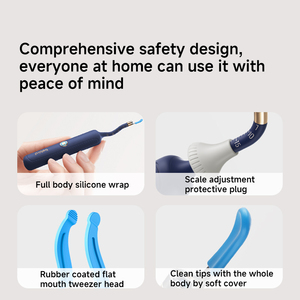
All categories
Featured selections
Trade Assurance
Buyer Central
Help Center
Get the app
Become a supplier

(882 products available)














































Otoscope bulbs are small, but they play a critical role in the functioning of the device. An otoscope is used for examining the ear, and the bulb is responsible for illuminating the area so that a clear view is possible. Different types of bulbs are used in Welch Allyn otoscopes, and they include the following:
Halogen bulbs
Halogen bulbs use a tungsten filament to produce light. The presence of halogen gas makes the light bright and durable. The gas is usually contained in a small quartz tube that forms part of the bulb. These Welch Allyn otoscope bulbs are popular because they produce light that is near white. The light is also very focused to illuminate a small area. Halogen bulbs have a long lifespan and consume less energy. However, they generate some heat. The heat is not good when the bulb is used with devices that have to be held close to the body. The heat can cause discomfort.
LED bulbs
When it comes to halogen vs LED light, the latter has many advantages. LED bulbs generate light without producing heat. This makes them ideal for use in devices that have to be held close to the body. They are also versatile and can be used for other medical devices. These Welch Allyn otoscope bulb replacements are more energy efficient than halogen bulbs. They have a longer lifespan and provide consistent brightness for the duration of their use. Nevertheless, LED bulbs are more expensive. They also need special optics for the light to be focused appropriately.
There are many functions of an otoscope. The device is essential in the medical field and has various applications. Some of its key functions include:
Some of the key features of an otoscope bulb replacement include:
There are various scenarios in which an otoscope bulb would need to be replaced. For one, bulbs have a limited lifespan and will burn out after a duration of time. The Welch Allyn bulbs have a typical lifespan of about 200 hours. The more the device is used, the sooner the bulb will burn out. The more the device is used, the more it will get hot. With time, the filaments inside the bulb can get weak or break, causing the bulb to burn out.
Doctors or healthcare professionals using the otoscope for medical examinations will notice that the light is dim or insufficient for viewing the ear canal and tympanic membrane. The light may also have flickering or intermittent patterns. This indicates that the bulb is nearing its end and will require replacement.
In scenarios where the otoscope is not used frequently, the light may become dim or fail completely. This is due to the bulb's filaments getting weak or breaking. Infrequent use of the device means that the filaments are not tightly secured. Some bulbs are prone to this issue even when not used for long periods. A good example is the halogen bulbs.
When an otoscope is dropped or subjected to any form of impact, the bulb may break or develop defects. This can lead to loss of light or produce a dark spot in the illumination. It can also cause the light to flicker or show intermittent patterns. Bulb replacement is necessary in this scenario.
A faulty or incompatible bulb can also cause illumination failure. If the bulb has a broken filament, it will need to be replaced. Bulb incompatibility can also cause dim light or intermittent flickers. In both cases, the current bulb needs to be replaced with a compatible or new one to restore functionality.
Worn-out batteries can cause insufficient illumination and signal the need for otoscope bulb replacement. When the batteries are worn out, they are unable to supply the required voltage to the bulb. This results in dim light. Replacing the batteries will eliminate the problem.
Choosing an appropriate replacement bulb requires careful consideration of multiple factors. The specific needs of the user should be given priority, as well as the compatibility of the bulb and its technical specifications.
Q1: Are there any tips for safely replacing the bulb in an otoscope?
A1: Yes, some tips include ensuring the replacement is compatible with the device, turning off the power before removal and installation, and handling the bulbs with tissue or gloves to avoid oil transfer.
Q2: What are the signs that the bulb needs to be replaced?
A2: Signs that the bulb may need replacement include dimmer light than usual and intermittent light failure. Also, if the light goes off completely, it is a sign that the bulb needs to be replaced.
Q3: Can a bulb be replaced if it breaks?
A3: Yes, it can be replaced. As a safety precaution, users should ensure they don't leave any broken pieces behind in the otoscope. The broken piece should be removed carefully.